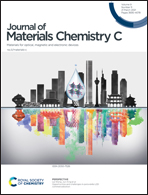Direct Z-scheme Sn-In2O3/In2S3 heterojunction nanostructures for enhanced photocatalytic CO2 reduction activity†
Abstract
The photocatalytic reduction of carbon dioxide into chemical fuels has great practical significance in solving the energy crisis and issues associated with environmental pollution, but it remains a big challenge owing to its low light absorption rate, sluggish charge separation/transfer efficiency, and poor stability of existing photocatalysts. Heterogeneous composites are promising in solving the problems of sunlight absorption and carrier separation in photocatalysis. In this study, a direct Z-scheme Sn-In2O3/In2S3 heterogeneous photocatalyst was constructed by chemical vapor deposition and vapor phase sulfuration. An optimized photocatalyst with Pt as a co-catalyst shows efficient photocatalytic activity in carbon dioxide reduction. The CH4 yield rate reached 0.41 μmol cm−2 h−1, and the CO yield rate is as high as 1.03 μmol cm−2 h−1. The favorable photoelectrochemical performance was attributed to the effective light absorption of In2S3 and improved charge transfer efficiency due to the direct Z-scheme structure of the composite photocatalyst. This work provides new ideas in the preparation of highly efficient recyclable photocatalytic systems by constructing Z-scheme nanostructured heterojunctions.



 Please wait while we load your content...
Please wait while we load your content...